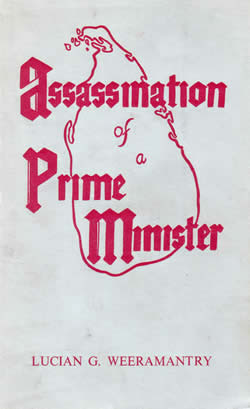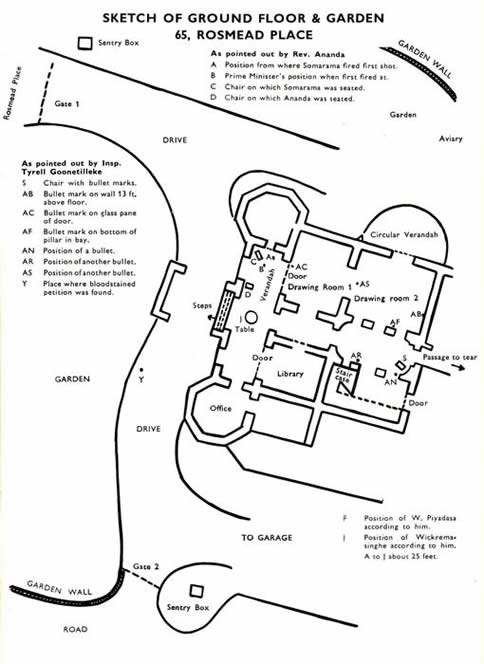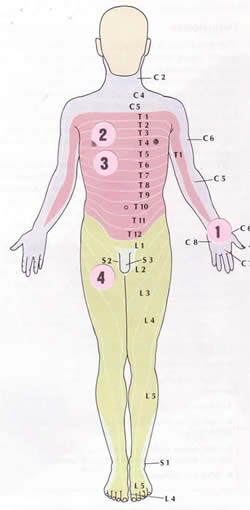Ilankai Tamil Sangam30th Year on the Web Association of Tamils of Sri Lanka in the USA |
||||
 Home Home Archives Archives |
Prime Minister Solomon Bandaranaike Assassination Revisited after 50 YearsPart 2: Forensicsby Sachi Sri Kantha, October 3, 2009
Introduction Consider the following comparable statistic. Between 1964 and 2008, over 30 technical papers have been published on the forensics of President John F. Kennedy's assassination (on Nov. 22, 1963) that occurred four years after the assassination of Prime Minister Solomon Bandaranaike. Not even one technical paper has been published on the forensics of the Bandaranaike assassination. The only available source of information that can be openly accessed is the book by Lucian G. Weeramantry entitled Assassination of a Prime Minister: The Bandaranaike Murder Case (1969, 312 pp). A few demerits have to be noted on this source. First, Weeramantry was the counsel who defended the fourth accused and assassin Talduwe Somarama Thero. Thus, a bias may be apparent. Secondly, this book was self-published in Geneva, after a lapse of 10 years following the assassination. Why a mainstream publisher in any country (including Ceylon) failed to evince interest (for whatever reason) in this theme has not been stated by the author. In his preface to the book, he recorded only this much: “The story of the conspiracy and the assassination is one so e Forensic Details presented by Weeramantry I provide below the details presented by Weeramantry in Chapter 15 of his book, entitled ‘A Foolish Man in Robes’ (pp. 93-100). For illustrative purposes, I also have scanned a sketch of the Bandaranaike residence (65, Rosmead Place, Colombo 7) where the shooting took place, presented in the book between pages 40 and 41. (1) Gun shot wounds in Bandaranaike’s body According to Weeramantry, Dr. W.D.L. Fernando, the judicial medical officer who had obtained a MRCP in forensic medicine in 1953 and had worked with British professors Sydney Smith, Glaister and Keith Simpson examined Prime Minister Bandaranaike’s injuries. To quote verbatim,
For illustrative purposes, I have used a human anatomy textbook illustration on dermatomes to indicate the four entrance wounds (1 to 4) in Bandaranaike’s body as noted by Weeramantry (items 1, 3, 4 and 6). Weeramantry continues further:
To recapitulate the details, the prime minister Bandaranaike was shot at 9:45 am on Sept. 25, 1959 (page 54). He then underwent a five hour operation at the Colombo General Hospital, from 11:15am to 4:15 pm (page 94). The following day, on September 26, 1959, Solomon Bandaranaike died at 7:45 am (page 94). And, no postmortem was held! The chief surgeon who operated on PM Bandaranaike was Dr. P.R. Anthonis. Other doctors who assisted Dr. Anthonis were, “Dr. Umagiliya, the anesthetist; Dr. Henry Perera, chest surgeon; Dr. Ponnambalam, another chest surgeon and Drs. Mendis and Yogeswaram, house surgeons.” Unfortunately, excluding Dr. Henry Perera, Weeramantry does not identify other doctors with their first names or initials. Another demerit of Weeramantry book is that a proper index was missing. I provide below, verbatim, the recorded interactions that transpired between Dr. P.R. Anthonis and the prime minister, as presented by Weeramantry (pages 93 to 96). “In the theatre he [i.e., Dr. Anthonis] asked Mr. Bandaranaike, ‘Sir, what happened?’ He replied, ‘Doctor, till I saw that black object emerge from the robe, I did not realize what was happening.’ ‘What robe?’ inquired Dr. Anthonis. ‘It was a Buddhist monk,’ was the reply. Feeling Mr. Bandaranaike’s pulse and finding it rising rapidly, he decided not to put him any further questions. After Dr. W.D.L. Fernando, the judicial medical officer, had examined Mr. Bandaranaike’s injuries, Dr. Anthonis began the operation. Immediately anesthesia was administered, Mr. Bandaranaike collapsed due to his low condition. His heart stopped beating and for a moment all seemed lost. Losing no time, Dr. Henry Perera, the skilful and experienced chest surgeon, stepped in and proceeded to give the lifeless patient a cardiac massage, while the attending surgeons and nurses kept casting doubtful glances at one another. But soon, to the surprise and relief of all, the heart resumed its beat. The prime minister had revived! Dr. Anthonis found that there was a very large quantity of free blood inside the abdominal cavity, with the result that only half the normal quantity of blood was in circulation. From the patient’s response to anaesthesia, it was clear that his condition was very serious and the object of the operation was no more than to endeavour to prolong life. Had the operation not been performed, Mr. Bandaranaike would have died within half an hour. The operation, which took more than five hours, was over by 4:15 pm, by which time there was an appreciable improvement in his condition. In non-technical language, the nature of the operation was the stoppage of haemorrhage by ligatures and sutures, or, in other words, the repairing of the perforations and lacerations caused by the bullet wounds. There was one bullet embedded close to the nineth rib, which was recovered by Dr. Henry Perera and handed over to the judicial medical officer. The internal haemorrhage was mostly of the liver, pancreas, spleen, omentum and intestines. Of the vital organs, it was only the kidney and the heart that had escaped injury.
Cross-examined by counsel for Somarama, Dr. Anthonis said that after the operation the prime minister dictated in his presence a message to be delivered to the nation. He had strongly advised Mr. Bandaranaike against it, but Mr. Bandaranaike was determined to do so and pressed him to consent. ‘Then make it very shrot’, he pleaded, giving his consent with the utmost reluctance. ‘Doctor, I am noted for long political speeches. Please do not restrict me’, was the prompt reply. In the operating theatre stood a man in a surgical mask all ready to take down the message. Mr. Bandaranaike told the man, ‘Do not take it down in shorthand. I want you to do so in long hand and read it back to me.’ The message, which turned out to be a fairly long one, was accordingly dictated and read back. It was subsequently published in all the newspapers.
Immediately after the message was dictated, the Governor General, Sir Oliver Goonetilleke, called at the hospital and spoke to the prime minister. Dr. Anthonis was nearby, but did not hear what the Governor-General said. He, however, did hear the prime minister say, ‘Do what you think is best.’ ‘Speaking of his assailant, did the prime minister tell you at any stage, ‘He is a foolish man and I do not know why he shot me’?’ ‘Yes, he said that about four times before he died. He called him a foolish man in robes.’ Court: ‘In other words, the prime minister was not attributing any personal motive to the man who shot him?’ ‘No’ Counsel: ‘Was a post mortem held on the prime minister’s body?’ ‘No’ ‘Was his dying deposition recorded?’ ‘No.’ ‘Would it be correct to say that, as soon as you saw the prime minister being brought in by car, it struck you that his dying declaration was important?’ ‘Yes, it struck me that it was important.’ ‘Whatever the physical condition of the prime minister may have been at that stage, he was in full possession of his mental faculties?’ ‘Yes’ Court: ‘In fact, he was cracking jokes in the operating theatre?’ ‘Yes’ ‘Did he once say, when you requested him to put his tongue out, ‘It is a long tongue. We politicians are very tough guys and have plenty of guts’?’ ‘Yes, that was after the operation.’ Dr. Anthonis emphasized once more that, although there was an improvement in Mr. Bandaranaike’s condition after the operation, he did not think that he could have survived. He did not take steps to have his dying deposition recorded, because any chance of recovery would have been lost had he been allowed to talk. He was, however, in full possession of his mental faculties to the last. Counsel: ‘Then, why did you not insist that he should not dictate this message to the nation?’ ‘I did insist many times, but he said, ‘Doctor, please allow me to do this.’ It was only humane for me to permit him to do so in the circumstances.’ ‘Was he not disposed to make a dying deposition?’ ‘I do not think that the question of dying ever entered his mind.’ ‘Were you aware that a C.I.D. officer, who was anxious to record his dying deposition, came to the hospital before he died?’ ‘No’ Dr. Anthonis attributed the cause of death to surgical shock and haemorrhage due to multiple gunshot injuries.” (2) Gun shot wounds in assassin Somarama Thero’s body It should not be forgotten that the assassin Somarama Thero also suffered gun shot wounds. He was shot by the police sentry (constable Samarakone, aged 54) who was on duty at the entrance of Bandaranaike residence between 9:00am and 12:00 noon on September 25, 1959. The description provided by Weeramantry, in his book (pp. 54-55), is as follows: “Constable Samarakone said that at about 9:45 am he heard two shots from the direction of the house. He first mistook the sound for that of bursting firecrackers. As he turned towards the house, he heard two or three more shots. He heard all these shots in the space of a minute. He immediately loaded his rifle and ran in the direction of the verandah. He had not reached the verandah, when an elderly gentleman came running up to him and told him that the primeminister was being shot. As he stepped on to the verandah, he saw a Buddhist monk in the corridor. ‘The elderly gentleman pointed out the monk to you?’ ‘Yes’ ‘And told you something?’ ‘Yes’ ‘What happened then?’ ‘The monk turned towards me and attempted to run in my direction. I feared that I too might be shot.’ Court: ‘But did you see a revolver or any other weapon in his hands?’ ‘I did not.’ …The monk had his outer robe raised. His hands were concealed and I did not notice him having a revolver. But fearing that he may be armed and may shoot me, I fired at him with my rifle and he was injured. I identify the monk I shot at as Somarama, the fourth accused.” According to the descriptions presented by Weeramantry, assassin Somarama Thero was examined by forensic doctor W.D.L. Fernando, after (emphasis mine) the death of prime minister at 1 pm on September 26th. He was operated by Dr. Austin (again, first name or initials were missing for this doctor.) To quote Weeramantry (pages 98-99): “Somarama was in the operating theatre adjoining that of the prime minister. The following were the details of his gunshot wounds: 1. Circular punctured lacerated wound on the back of the right side of the right thigh. 2. Lacerated wound on the back of the inner side of the right thigh, slightly higher than injury 1. 3. Laceration of the scrotum with injury to the right testicle. 4. Lacerated wound on the inner side of the back of the right thigh at the same level as the injury to the scrotum. Injury 1 was an entrance wound and 2 was the corresponding exit wound. Injury 1 was consistent with an injury caused by a rifle bullet. Its position indicated that the fourth accused was shot from a side. Injuries 3 and 4 were caused by the same bullet which caused injuries 1 and 2. That meant that the bullet, having entered through the back of the right thigh on the outer side, would have emerged from the inner side, grazing the scrotum and the left thigh when making its exit. ‘Could these injuries have been caused if the assailant stooped down and shot at the injured man while he lay fallen?’ ‘Yes, if the assailant and the injured man had both been on the same level at the time of firing.’ In addition to these injuries, Somarama had a lacerated wound on his forehead suggestive of a fall or an assault with a rough object, contusions on his head and face suggestive of fist blows, contusions on his chest suggestive of blows with clubs, and a bite mark on his back which turned out to be a grievous injury. Dr. Austin, who operated on Somarama, found it necessary to remove one of his testicles.” Some Inferences (1) As per Solomon Bandaranaike cracking jokes in the operating theatre, that he had ‘a long tongue and plenty of guts’, provided by Dr. P.A. Anthonis (who attended on Solomon Bandaranaike), one may note that the SLFP’s founder-leader did possess some sense of humor. And that he insisted on delivering a public message to the nation (even at his critical hour) proves that Bandaranaike was a supreme politician of a kind. (2) That the two life threatening gun shot wounds in prime minister Bandaranaike’s body were on his right side (thus missing the heart), and none were above the neck, it may be postulated that his assassin Somarama may have been misdirected by the movement of his target or that he simply misjudged the right from the left. (3) The identified gun shot wounds in assassin Somarama Thero’s body indicates that constable Samarakone had primarily aimed at the below-waist region to immobilize his threatening target. (4) On the issue of having a proper postmortem done to prominent victims of assassinations, one may wonder why Sri Lankans are so allergic. Precedence may have been set with primeminister Solomon Bandaranaike’s murder. It was revealed that in last May, no postmortem was done on the LTTE leader Prabhakaran’s body. Even no postmortem findings were released either after JVP leader Rohana Wijeweera’s death in 1989 or on President Ranasinghe Premadasa’s death in 1993. ***** |
|||
|
||||
 xtraordinary, so gripping and so fantastic, that I felt it should be told to the world in an easy, abbreviated form, which yet preserves its most interesting features. Hence this book.”
xtraordinary, so gripping and so fantastic, that I felt it should be told to the world in an easy, abbreviated form, which yet preserves its most interesting features. Hence this book.” After the operation, Dr. Anthonis left the hospital but returned at about 6:30m. He was thereafter almost continuously by the prime minister’s bedside till he passed away at 7:45 am on September 26th. Although the operation had succeeded in arresting the bleeding, its immediate object, it had failed to save life.
After the operation, Dr. Anthonis left the hospital but returned at about 6:30m. He was thereafter almost continuously by the prime minister’s bedside till he passed away at 7:45 am on September 26th. Although the operation had succeeded in arresting the bleeding, its immediate object, it had failed to save life.